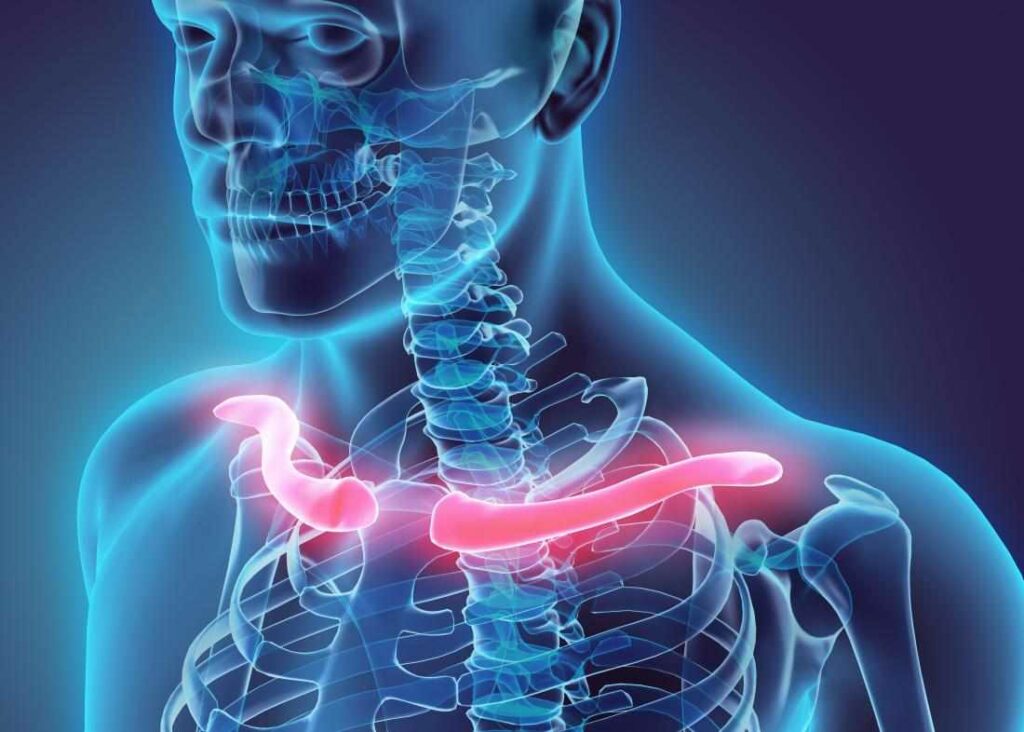Clavicle pain can be a real nuisance. It can make it difficult to sleep, and it can be hard to do everyday tasks with that nagging pain in your shoulder. In this blog post, we will discuss the causes of it, as well as some treatment options. We will also provide you with some tips on how to prevent it from occurring in the first place. Keep reading for more information!
Contents
What Is Clavicle Pain?
 Clavicle pain is a condition that is specific to the clavicle, or collarbone. The collarbone connects your sternum and shoulder blade together, so it’s no surprise that injuries can occur there.
Clavicle pain is a condition that is specific to the clavicle, or collarbone. The collarbone connects your sternum and shoulder blade together, so it’s no surprise that injuries can occur there.
Clavicle pain actually affects both ends of the bone—the proximal end (which attaches to the sternum) and the distal end (which attaches to the scapula).
There are many possible causes of it, including:
- fractures,
- dislocations,
- muscle strains.
If you have clavicle pain, it’s important to see a doctor for treatment. They will be able to diagnose the cause of your pain and recommend an appropriate course of action.
How Is It Diagnosed?
Diagnosis is done when the doctor takes a look at the condition of your clavicle. They will assess if there is any swelling and feel the area for tenderness and pain. If they suspect any broken bones, they will perform certain tests to confirm their suspicions.
There are several methods that doctors use to diagnose it such as :
Physical Examination
The doctor will feel the area of your clavicle to look for any swelling or tenderness. They may also ask you to move different parts of your shoulder or arm so they can assess how your muscles and ligaments are functioning.
X-rays
While x-rays cannot detect soft tissue damage, they can help confirm if your clavicle is broken or fractured. If a fracture is suspected, the doctor may order additional imaging tests, such as an MRI scan or CT scan, to get more detailed information about the extent of the damage.
Ultrasound
An ultrasound uses sound waves to produce images of soft tissue structures, such as ligaments and tendons. This imaging technique can also be used to rule out tendonitis or other soft tissue injuries that may be causing your clavicle pain.
If you are experiencing clavicle pain, it is important to see a doctor right away for diagnosis and treatment. Depending on the cause of your pain, your doctor may recommend physical therapy, pain medications, or other treatments to help you get relief and prevent further injuries.
Treatments For Clavicle Pain

Treatments for clavicle pain vary depending on the cause and severity of the problem, but some of the most common include:
Rest And Ice
When you first notice clavicle pain, the best thing to do is to rest your affected arm or shoulder and use a cold compress on the injured area to reduce swelling. After a day or so of this, gently start strengthening exercises that don’t put too much pressure on your clavicle bone.
Exercises
If the pain is mild and your clavicle injury happened due to a sports-related accident, you may be able to continue participating in normal activities once your main symptoms have subsided. For example, if your clavicle feels a little sore but your arm isn’t too weak or stiff, you may want to try gentle physical therapy exercises. These types of exercises and stretches can strengthen your affected arm and shoulder, improving the overall health and wellness of the area.
Surgery
If your clavicle pain is very severe or doesn’t improve after a few weeks of rest and other treatments, then you may need joint surgery. This is usually reserved for patients who are experiencing damage to the clavicle and surrounding tissue that can’t be successfully treated in another way, although it may also be necessary if you suffer from a shoulder separation or broken collarbone.
Medication
If your clavicle pain is causing significant discomfort and interferes with your ability to work or sleep, you can consider taking medication such as acetaminophen (Tylenol), ibuprofen (Advil), and nonsteroidal anti-inflammatory drugs (NSAIDs). These types of medications can help to lessen the injury and swelling associated with clavicle fractures.
Although clavicle pain can be quite irritating and difficult to deal with, most cases improve with some rest, ice, medication, and possibly physical therapy exercises. Surgery becomes necessary when other treatments do not work. Talk to your doctor about what treatment options are best for you in order to get relief from pain soon.
Is Physical Therapy Best Option To Cure Clavicle Injury?

Clavicle pain can be cured from different other options by physiotherapy is still a debatable topic among various physios but this thing is often neglected by many which in turn leads to loss of health and money.
Clavicle pain, also known as clavicular pain, can be caused by a number of different conditions. It can be caused due to fractures, sprains, strains, arthritis, and nerve compression. For most people, clavicle pain can be treated with non-surgical methods, such as physical therapy and other types of rehabilitation.
Physical therapy is an effective option for many people suffering from clavicle pain. A physiotherapist will work with you to design a customized treatment plan that may include manual adjustments, stretches, and exercises to help alleviate your symptoms and improve your range of motion.
If you are suffering from clavicle pain, it is important to consult with a qualified physical therapist soon. According to your needs, your therapist will plan out exercises. They will also provide the guidance and support you need on your road to recovery.
How Long Does It Take To Heal Clavicle Pain?
Clavicle pain can be very debilitating, making it difficult to perform even simple tasks. It can last for a long time and make life quite uncomfortable. If you’re experiencing this pain, you may wonder how long it will take before the aches ease up and you feel like yourself again.
While there is no definitive answer, it’s generally understood by most healthcare professionals that clavicle pain can take up to six weeks to heal. This is due to the fact that the clavicle is involved in a lot of motion on a regular basis and can be very easily stressed during daily activities like carrying groceries or lifting heavy objects.
Prevention Tips
In order to not suffer from clavicle pain, you will need to take a few preventative measures. Let us discuss them below.
1. Wear a clavicle brace. This will help to support the weight of your upper body. It will also prevent you from suffering from injury-related pain in the future.
2. Make sure that you are not overworking or straining your shoulders and muscles. Pay attention to how much pressure and strain you are placing on your shoulders. Also, avoid doing any strenuous lifting or carrying heavy objects.
3. Practice good posture by keeping your shoulders back and your head up. Not only will this help to relieve existing pain, but will also prevent developing clavicle pain in the future.
4. Consider seeing a physical therapist if you are experiencing persistent pain. A physical therapist can help to identify any musculoskeletal imbalances or weaknesses that may be contributing to the pain. They will also provide you with targeted exercises and stretches that can help to relieve your symptoms.
If you are experiencing severe clavicle pain, it is important to seek medical attention right away.
Conclusion
To conclude, clavicle pain can be the result of several different factors. Different clavicle pain can be treated with varying degrees of success. If you experience any clavicle pain, it is important to visit your doctor for an accurate diagnosis and treatment plan. For more information about it, speak to your doctor or look online for additional resources.
Physical Therapy help patients recover from pain. If you’re experiencing Back pain, Shoulder pain, Knee pain, Neck pain, Elbow pain, Hip pain, or Arthritis pain, a physical therapist at MantraCare can help: Book a physiotherapy session.


